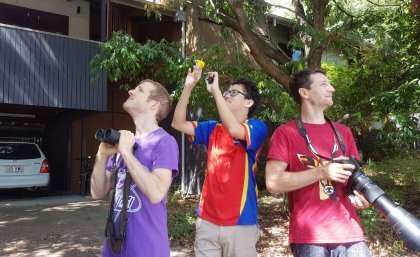Credit: Unsplash
A challenge by three housemates to identify species around their inner-city Brisbane home has resulted in an academic research paper, showcasing the rich biodiversity of urban landscapes.
UQ mathematician Dr Matt Holden, ecologist Dr Andrew Rogers and taxonomist Dr Russell Yong surveyed their shared Annerley home and garden during the 2020 COVID-19 lockdowns and discovered 1,150 unique species of animals, plants and fungi. a period of 12 months.
“We asked a lot of ecologists and conservation scientists how many species they expected to find in this setting and they only predicted 200,” Dr Holden said.
“But after 60 days of prospecting, we had already discovered 777 species.
“This shows that suburban homes and apartments could have much more biodiversity than ever imagined, especially when it comes to insects.”
The idea for the species count came about when Dr. Rogers went to vacuum the cobwebs in his room and wondered how many spiders were on the property.
“The three of us quickly came up with a plan to scour the house and garden for other creatures that resided alongside us,” Dr Holden said.
The survey revealed creatures of rich biodiversity, including 436 species of moths and butterflies, 56 different spiders, eight reptiles and 56 birds.

Credit: University of Queensland
Bird species included tawny frogs, laughing kookaburras, blue-faced honeyeaters, rainbow lorikeets, spotted doves and Brisbane’s favorite, the Australian white ibis.
“Blue-tongued skinks hibernated under the garage and at night blue-banded bees and teddy bears slept in the hedges under the front window,” Dr Holden said.
The researchers were also surprised to discover three species not previously recorded in Australia’s main biodiversity database, Atlas of Living Australia: a mosquito, a sandfly and an invasive flatworm, Platydemus manokwari, which is responsible for the decline in populations of native snails around the world.
“The house was a complex ecosystem of interacting species – we came across the Scatochresis innumera butterfly, which, as a caterpillar, spends all of its time feeding in the droppings of a Brushtail Possum before becoming an adult,” Dr. Holden said.
“The Parilyrgis concolor is another species of butterfly whose caterpillar lives in spider webs and devours spider droppings to survive.”
Dr Holden said homes in all urban areas could support similar biodiversity.
“It depends on how people look after their homes and gardens: keeping low-maintenance trees and shrubs and eliminating well-manicured lawns and pesticides will significantly increase the number of creatures found,” a he declared.
“You don’t need to travel to connect with Australia’s species diversity, just look in your own backyard.”
The research is published in Ecology.
More information:
Andrew M. Rogers et al, The House of a Thousand Species: The Untapped Potential of Comprehensive Biodiversity Censuses of Urban Properties, Ecology (2023). DOI: 10.1002/ecy.4225
Provided by the University of Queensland
Quote: Three researchers show their suburban backyard is home to more than 1,000 species (December 7, 2023) retrieved December 8, 2023 from
This document is subject to copyright. Apart from fair use for private study or research purposes, no part may be reproduced without written permission. The content is provided for information only.



